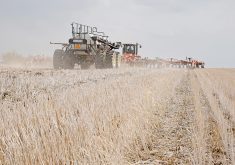Most producers are aware that farm property can be passed to the next generation without tax consequences if certain conditions are met.
However, what if you want to relocate your operation? What if an opportunity arises to sell farmland at a premium but you wish to purchase other land in another area? What if you would like to trade a quarter of land with your neighbour?
Each of these situations could result in a hefty tax bill. This is where replacement property rules may come into play.
Read Also

Proactive approach best bet with looming catastrophes
The Pan-Canadian Action Plan on African swine fever has been developed to avoid the worst case scenario — a total loss ofmarket access.
In general, if you sell an asset but replace it with a similar asset for the same or similar business use within a certain time frame, you may be able to defer your capital gains. If you sell farmland, you would need to buy a new piece of farmland to use replacement property. These rules can allow farmers to avoid recognizing the capital gain on the sale of land by reducing the cost base of the new land purchased. This means the capital gain will be deferred until the replacement land is sold.
To illustrate, Bob owns a section of land that has been in his family for generations. The land was bought for $100,000 and is now worth $1 million. Bob knows that if he were to sell the land, it would result in a capital gain of $900,000. Bob could face a tax bill of up to about $225,000 in the prairie provinces if he sits in the top tax bracket and is not eligible to use his lifetime capital gains exemption.
However, if Bob buys a new piece of land for $1.5 million within one year and makes the replacement property election, the capital gain could be reduced to $0. Instead of the new land having a cost base of $1.5 million, it will be reduced to $600,000 and the capital gain will be deferred until the new land is sold.
Bob should consider that if he buys replacement property for less than $1 million (the proceeds of the original land sale), it will not eliminate the capital gain, but could reduce it.
To completely defer the capital gain on the original land sale, the replacement property must be of equal or greater value than the proceeds received from the original land sale. In Bob’s case, this means his replacement property must be bought for a minimum of $1 million to eliminate the capital gain.
When the land sale is a voluntary disposition, such as a sale to a neighbour or land developer, the replacement property must be purchased within one year of the original sale. When the land sale is an involuntary disposition, such as a government expropriation, the replacement property must be purchased within two years of the original sale. It is important to keep in mind that you can also buy the replacement property before selling the initial property.
There are several restrictions and rules that apply to replacement property transactions. If you are contemplating moving your farming operations, you should seek professional advice to determine an action plan to achieve the best results.
Colin Miller is a chartered accountant and partner with KPMG’s tax practice in Lethbridge. Contact: colinmiller@kpmg.ca.
















